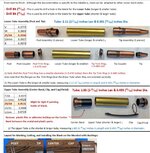As with all things in the machine tool world, typical "standard" drill bits are machined and thus have a tolerance. Most are targeted to be on the low side of the "nominal" dimension as most drills and drilling setups do not drill perfectly round holes. That's why in the machine tool world we use reamers whenever precise hole dimensions are necessary.
Part of the difference between the specified sizes in the instructions is likely due to the drilling stability of the material - with wood being less stable I would typically use a slightly larger bit if available (and practical). That being said, I often make the same choice when it comes to plastic blanks as the hole gets smaller depending on how thick and how many layers of paint I apply.
As a side note, I have found that most pen kit instruction sheets are not written using a highly technical vernacular. It is usually rare to see key dimensions even included for key components and it would be shocking if they included the tolerances.
I have also found that there are a lot of conversion rounding factors that come into play. As Darios pointed out, the 0.492 inches in the instructions has most likely been rounded or truncated from the mathematical conversion of 12.5mm. (12.5mm = 0.492126 inches).
On the kits that I use the most often, I create my own "Quick Reference Sheet" for drilling and assembly so that I can have a reference all of the dimensions and stuff at hand when I am working. As can be seen in the thumbnail attachment, I usually include a bracketed table for drill bit sizes so I can choose appropriately depending on the blank material I am using and since they too have an unspecified tolerance, on an empirical OD measurement of the actual brass tubes in the kit.
Regards,
Dave
Click on Thumbnail to Enlarge


